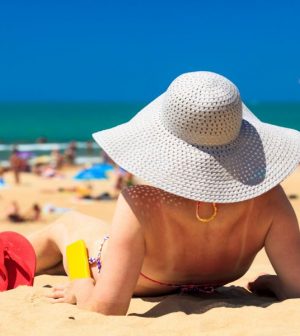- Skip Storing This Everyday Product in the Fridge Door
- Green Tea + B3 Pairing May Boost Brain Health
- Navigating Your Midlife Crisis: Embracing New Possibilities
- City Raccoons Showing Signs of Domestication
- Mapping the Exposome: Science Broadens Focus to Environmental Disease Triggers
- One Week Less on Social Media Linked to Better Mental Health
- Your Brain Changes in Stages as You Age, Study Finds
- Some Suicide Victims Show No Typical Warning Signs, Study Finds
- ByHeart Formula Faces Lawsuits After Babies Sickened With Botulism
- Switch to Vegan Diet Could Cut Your Greenhouse Gas Emissions in Half
Flip-flops: Fun in the Sun, but Tough on Feet

Americans love flip-flops — just slip them on, and you’re out the door.
But, the unstructured footwear can cause problems, one expert says.
“This time of year I frequently see patients with foot conditions related to wearing flip-flops,” Dr. Christina Long, a podiatrist and foot and ankle surgeon at Wake Forest Baptist Medical Center, said in a center news release.
“Wearing flip-flops is better than going barefoot because they do provide some protection for the bottoms of your feet, but that’s about it,” she said.
“Flip-flops don’t offer any arch or heel support, and you have to grip them with your toes to keep them on. Wearing them for too long or for the wrong activity can cause a lot of different problems,” she explained.
Flip-flops leave feet exposed and susceptible to cuts, puncture wounds, bruises, torn nails, insect bites and sunburn. Walking in flip-flops also can alter your natural stride, resulting in shin splints, Achilles tendon problems and lower back pain.
It’s also easy to stub a toe or trip and fall while wearing flip-flops.
Wearing flip-flops too often can lead to minor problems such as chafing, blisters, calluses, soreness to more serious issues such as plantar fasciitis (inflammation of the band of tissue that runs from the heel to the ball of the foot), hammer toes and stress fractures, Long said.
But Long added that the popular footwear is OK if you’re wearing them for a brief time.
“Flip-flops are fine for short-term use, especially if they have at least some arch support and a cushioned sole. They’re good to wear at the beach, around swimming pools, in showers and locker rooms at the gym, on short trips to the store,” she said.
If you want to wear flip-flops, look for those made of high-quality, soft leather, which minimize the potential for blisters and other types of irritation, the American Podiatric Medical Association recommends.
Gently bend the flip-flop from end to end, ensuring that it bends at the ball of the foot — it should not fold in half — and make sure your foot doesn’t hang off the edge of the flip-flop. The APMA added that all of your shoes — not just flip flops — should be slightly bigger than your feet.
Inspect older flip-flops and throw them away if they show signs of severe wear.
There are some activities where you should forgo the flip-flops, however. Driving is one of them. Long said it’s easy for the shoes to slip off and they can get lodged between the pedals and the floor.
Also, she said, leave your flip-flops in the closet if you plan on running, hiking, walking long distances, standing for extended periods, working in the yard or around the house or playing sports.
More information
The American Podiatric Medical Association has more on flip-flops.
Source: HealthDay
Copyright © 2025 HealthDay. All rights reserved.










